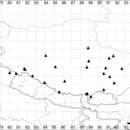Description
provided by Phytokeys
Monoecious annuals up to 20 cm with scattered, long-stalked bladder hairs; stems branched, prostrate or ascending; at elevations above 5000 m plants are often cushion-like. Leaves fleshy or not, petiolate (petiole up to 1.5–2.0 cm), green, leaf blades up to 1.5 cm, decreasing in size upwards, entire, rhombic, ovate or oblong, mostly entire or sometimes with small lateral lobes. Male flowers inconspicuous with (4)5 hyaline perianth segments and 2–4 stamens with large (ca. 2.0 mm) protruding filaments in anthesis, anthers ~0.5 mm; female flowers hidden in bract (each bract usually covers 3 female flowers) without a conspicuous perianth. Fruits and seeds dimorphic. The fruits of the first type reddish-brown, 0.9–1.0 mm long, 0.4–0.5 mm thick, ear-like pericarp appendages in the upper part of the fruit up to 0.1 mm and much smaller in the lower part; pericarp one-layered, some cells papillate; seed testa 10–12 µm thick, undulate, outer cell walls with stalactites. The fruits of the second type dark, 1.0–1.5 mm long, 0.75–0.80 mm thick (visibly swollen) with ear-like pericarp outgrowths up to 0.1 mm expressed throughout; pericarp one-layered with papillate cells, 12–15 µm; seed coat testa 20–25 µm thick. Seed coat tegmen of both seed types minute; embryo vertical, annular; perisperm present. The fruit anatomy is similar to that of Archiatriplex Chu (Kadereit et al. 2010), especially in the presence of pericarp outgrowths over the fruit surface (Sukhorukov 2014).
One species in Himalaya, Tibet, Pamir and Tian Shan.
- license
- cc-by-3.0
- copyright
- Alexander P. Sukhorukov, Pei-Liang Liu, Maria Kushunina
- bibliographic citation
- Sukhorukov A, Liu P, Kushunina M (2019) Taxonomic revision of Chenopodiaceae in Himalaya and Tibet PhytoKeys (116): 1–141
- author
- Alexander P. Sukhorukov
- author
- Pei-Liang Liu
- author
- Maria Kushunina

